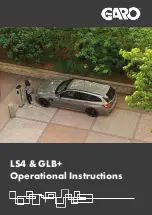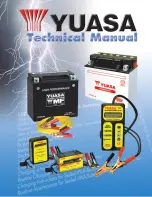
Operation as a power supply (12V-/24V-Version)
Output voltage
DIP switches
13,2V / 26,4V
13,5V / 27,0V
13,8V / 27,6V
4
OFF
OFF
ON
5
OFF
ON
OFF
6
ON
ON
ON
DIP switches 1, 2 and 3 switch off automatically (regardless of the On/Off position) if DIP
Î
switch 6 is set to "ON".
Attach the mains cable to the power supply (8) and a mains socket with safety contact.
•
Attach terminal (3) and then terminal (4) to the battery to be charged or to the consumer to
•
be supplied. Ensure correct polarity (RED = plus pole/+; BLACK = minus pole/-).
When connecting batteries and consumers, observe the manufacturer's Operating
Î
Instructions (when connecting vehicle batteries the vehicle manufacturer's Operating
Instruction).
Turn the main switch (9) to "ON".
•
The LED "POWER ON" illuminate. The LEDs "FLOAT", "ABSORPTION" and "BULK" illumi
-
nate depending on the operating modes.
When the device is fully charged or when the charger is no longer being used as a power
•
source, turn the main switch (9) to "OFF".
Disconnect terminal (4) and then terminal (3) from the battery or the consumer.
•
Isolate the mains lead from the socket.
•
On this version of the device, the data interface (7) has no function.
Î
OPERATING MODES
Battery charger (booster) mode
This intelligent charger completes the charging operation automatically in four phases.
Phase 1
: Preparation of a low or severely discharged battery in order to optimise current ac-
ceptance. The LEDs "POWER ON" and "BULK" illuminate.
Phase 2
: After approx. 30 minutes, the device switches to the next phase; the battery is
charged with the output voltage. The LEDs "POWER ON" and "BULK" illuminate.
Phase 3
: After some time, the device switches to the ABSORPTION phase; the battery is fully
charged with max. charge current. The LEDs "POWER ON" and "ABSORPTION" illuminate.
Phase 4
: The battery continues to be charged with float voltage. This protects the battery from
overload and equalises any self-discharge. The LEDs "POWER ON" and "FLOAT" illuminate.
Power source mode
This device can also be used as a power source for a consumer.
The LEDs "POWER ON" and "FLOAT" illuminate.
CARE AND MAINTENANCE
Before cleaning, switch off the device. Then remove the battery (if any) from the device and
isolate the device from the mains voltage.
Clean the device with a soft, clean and dry cloth. Do not use aggressive detergents or chemi
-
cals as these can damage the housing (discolouration).
DISPOSAL
Device
Never dispose of devices bearing the symbol opposite in the household waste.
You are obliged to dispose of these used electrical and electronic devices
separately.
Ask your local authority about the facilities for controlled disposal. Separate
disposal passes used devices for recycling or other forms of reuse. This helps
prevent harmful substances from infiltrating the environment.
Batteries
As the end user, you have a legal obligation (battery regulation) to return all
used batteries; disposing of batteries in the household waste is prohibited!
Batteries containing harmful substances bear the symbols opposite. These
symbols mean that disposal in the household waste is prohibited. The designa-
tions for the decisive heavy metal area: Pb=lead (designation on the battery,
e.g. below the dustbin symbols, bottom left).
You can return your used batteries free of charge to your local collection points,
any of our branches or wherever batteries are sold!
In doing so, you are satisfying legal obligations and helping protect the environ-
ment.
SERVICE
Have your device repaired only by qualified persons. This will guarantee that the device
remains safe.
STORAGE AND TRANSPORT
Always keep the device cool and dry.
Protect the device from damage during transportation.
Isolate the battery to be charged from all consumers and leads (first switch off
•
all consumers!) before connecting it to the charger. Always isolate the earth
connection (minus pole) from the battery first and then the plus pole.
Before connecting the battery to the consumer(s), isolate the charger from the
battery.
Sparks can occur when connecting or disconnecting the battery. Adequate
ventilation should therefore be provided!
If you are not sure how to connect or operate correctly or if you have any questions that are
not answered in the Directions for Use, contact our Technical Information Service or other
qualified person.
Voltcraft®, Lindenweg 15, D-92242 Hirschau, Tel. +49 180 5865827.
THE DEVICE AT A GLANCE
Charger display
1.
Connection screw (+), 2 x
2.
Connection terminal (+)
3.
Connection terminal (-)
4.
Connection screw (-)
5.
DIP switches (for operating
6.
modes)
Data-interface (only for the
7.
manufacturer)
Mains connection
8.
Main switch (On/Off)
9.
CONNECTION AND OPERATION
Always make sure the DIP switches are set correctly for the mode in which
you are operating the device and for the battery type to be charged. There
is a risk of fire and explosion!
Always make sure the DIP switches are set correctly for the input voltage
on the consumer. There is a risk of fire and explosion!
Make sure that the main switch (9) is set to "OFF".
•
Attach the fork-shaped lug on the RED cable to the terminal (2) on the device. Tighten the
•
screw.
Attach the fork-shaped lug on the BLACK cable to the terminal (5) on the device. Tighten
•
the screw.
Set the DIP switches (6) correctly for the desired operating mode.
•
Refer to the tables.
Operation as a battery charger (12V-/24V-Version)
Battery type
DIP switches
SLA/GEL
AGM/lead-acid
battery
Lead-acid battery
with calcium board
1
OFF
OFF
ON
2
OFF
ON
OFF
3
ON
OFF
OFF
4
OFF
OFF
ON
5
OFF
ON
OFF
6
OFF
OFF
OFF
Output voltage
14,2V / 28,4V
14,6V / 29,2V
14,8V / 29,6V
Float voltage
13,2V / 26,4V
13,5V / 27,0V
13,8V / 27,6V
3
2
5
6
9
7
8
4
1






























